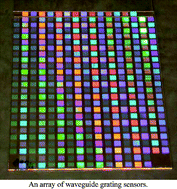Self-referencing a single waveguide grating sensor in a micron-sized deep flow chamber for label-free biomolecular binding assays
Abstract
In order to allow the design of increasingly sensitive label-free biosensors, compensation of environmental fluctuations is emerging as the dominant hurdle. The system and technique presented here utilize a unique combination of microfluidics, optical instrumentation, and image processing to provide a reference signal for each label-free biomolecular binding assay. Moreover, this reference signal is generated from the same sensor used to detect the biomolecular binding events. In this manner, the reference signal and the binding signal share nearly all common-mode noise sources (temperature, pressure, vibration, etc.) and their subtraction leaves the purest binding signal possible. Computational fluid dynamic simulations have been used to validate the flow behavior and thermal characteristics of the fluids inside the sensing region. This system has been demonstrated in simple bulk refractive index tests, as well as small molecule (


 Please wait while we load your content...
Please wait while we load your content...